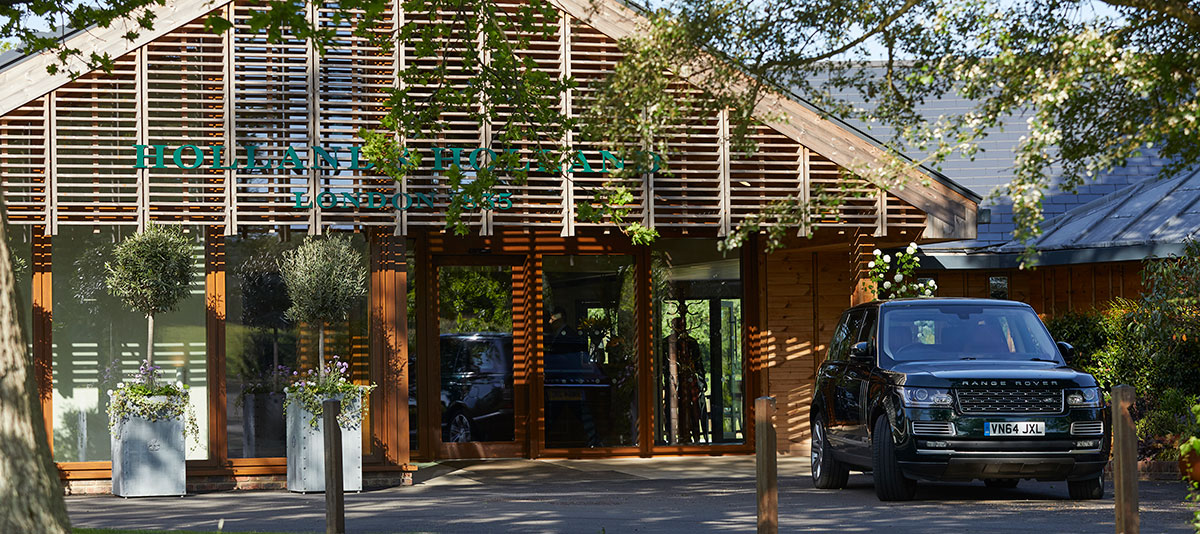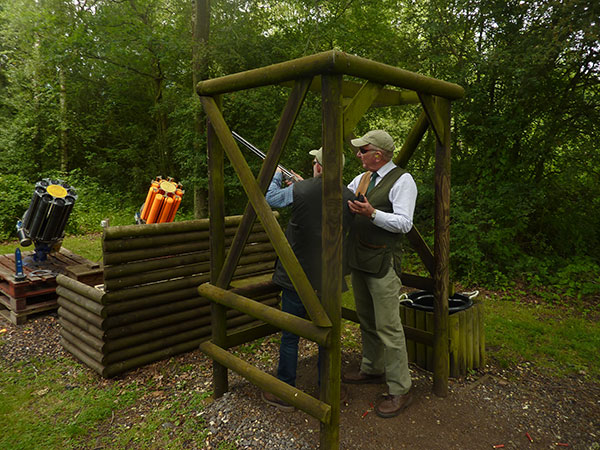[et_pb_section bb_built=”1″ inner_width=”90%” inner_max_width=”1086px”][et_pb_row][et_pb_column type=”3_4″ custom_padding__hover=”|||” custom_padding=”|||”][et_pb_image _builder_version=”3.17.6″ src=”https://0ld.basc.org.uk/wp-content/uploads/2019/07/euan-holland-and-holland-stands.jpg” align_last_edited=”on|desktop” align_tablet=”center” /][et_pb_text admin_label=”Journalist Story” _builder_version=”3.17.6″]
Back in May, I had the fantastic opportunity to visit the Holland and Holland factory in Kensal Green where I met their world-renowned gunsmiths and the six new apprentices they’re currently training. I then visited their private shooting ground where I took two of their guns out clay shooting.
The factory is Victorian, built in 1898. What’s striking is its North London location, which seems an unusual choice. Yet, one must appreciate that Holland and Holland were there first. They even test-fired guns in what was acres of pasture surrounding the factory. Kensal Green came later.
What’s even more remarkable than the factory itself is what goes on inside. The craftsmanship is hard to comprehend, with no two guns being the same. A gun from start to finish takes around 12 months minimum to complete, reflecting the sheer level of dedication and skill that goes into each gun. With such a complex production process – crafting the barrel, carving and shaping the stock, designing and constructing the action, painstakingly engraving the side-plates and then concluding the process with the finishing refinements – there is a wealth of knowledge to be passed on and continued. It’s also worth noting that Holland and Holland are the only gunmaker to still make the barrels in the UK.
Yet, up until recently, there was no-one to pass it on to. With nothing written down, the future of this accumulated skill and knowledge hung precariously in the balance. Holland and Holland are therefore keen to promote ‘The next generation of Holland and Holland’. In September 2018, Holland and Holland launched their new apprenticeship scheme, the first for over 30 years. Through this, six highly-talented young people are now in the process of preparing to specialise in their favoured area of gunsmithing. I will cover this in greater detail in my upcoming feature for the Shooting and Conservation magazine.

My visit to their shooting grounds further reflected the drive to modernise and diversify the brand. The clubhouse is in the final stages of renovation, with a large open fireplace sat between a brand-new bar to the left and a gun cabinet and clothing section to the right, should you like to purchase any Holland and Holland products after your visit. The other half of the clubhouse is a venue to hold events like corporate days, with a meeting room that has the striking feature of a wine collection spanning the entire right-hand side. Two large reception rooms can also be merged into one, enabling organisers to seat over 200 people. Underneath the clubhouse is the only civilian cinematic rifle range of its kind in the UK, simulating anything from wild boar to African big-game.
Across the 130-acre site, they have embarked on a programme of conservation and improvement, creating ponds and wildflower areas, and introducing tree planting programmes to form a haven for wildlife just on the edge of West London.
The grounds have one of the largest networks of clay traps in the UK. Our two-hour shooting session included using their famous high tower, which can launch clays across at 180 degrees. Although challenging at first, after some coaching I was able to consistently hit targets from multiple directions.
Before the season begins, shooters can also make use of grouse butts and traps set to accurately mimic grouse flight patterns.
The shooting tuition I received was of the highest level, with every instructor following the same tuition method which is based on the ethos of ‘the Holland and Holland way’, while the guns came into their own on the range.
I am therefore very thankful to both BASC and Holland and Holland for such a unique experience. I hope that the legacy of skill and quality will continue and that London gunmaking remains secure for decades to come.
[/et_pb_text][/et_pb_column][et_pb_column type=”1_4″ custom_padding__hover=”|||” custom_padding=”|||”][et_pb_sidebar _builder_version=”3.17.6″ area=”et_pb_widget_area_19″ orientation=”right” /][/et_pb_column][/et_pb_row][et_pb_row][et_pb_column type=”4_4″ custom_padding__hover=”|||” custom_padding=”|||”][et_pb_team_member admin_label=”YS-Journalist Euan Trower Bio” _builder_version=”3.17.6″ name=”Euan Trower” position=”Young Shot Journalist” image_url=”https://0ld.basc.org.uk/wp-content/uploads/2018/11/Euan-trower-pic.jpg” custom_css_member_image=”width: 200px;” module_class=”ys-journalists-bio” custom_css_main_element=”border-top: 2px solid #078463;||border-bottom: 2px solid #078463;||border-right: 0px solid transparent; ” saved_tabs=”all”]
I’m 18-year-old A-level student from rural Devon. The countryside will always be a crucial part of me. I spent most of my childhood outside with friends, building dens, climbing trees and exploring the countryside which felt like an uncharted wilderness.
A fundamental part of my growing up was learning how to use guns and knives responsibly; I now respect them as essential tools. I didn’t learn hunting as a cruel, outdated endeavour; I learned hunting as a way to maintain the bond between countryman and countryside. However, this way of life is threatened by increasingly intolerant views based on simple misunderstanding. For many, the countryside is redundant, hunting is cruel and the people who live there nothing more than tourist attractions. This is why in my article I call for greater opportunity to be given to people who’ve never experienced the world I live in, so they can learn to appreciate rural Britain too.
[/et_pb_team_member][/et_pb_column][/et_pb_row][/et_pb_section]
